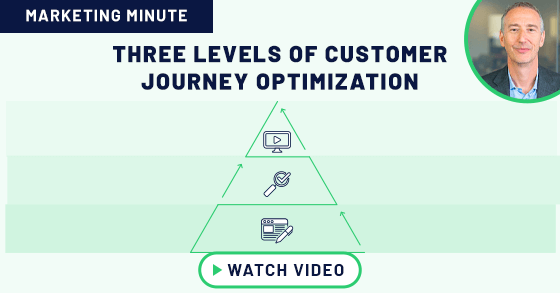
Why ABM?
Account based marketing, or ABM, has received enormous amounts of hype both online and in print, but this revolutionary approach to B2B marketing is not just another buzzword. In essence, ABM is a highly successful targeted marketing strategy that marries an organization’s sales and marketing teams to focus their efforts on only a few select accounts. Accounts are carefully selected and marketing campaigns for these targeted accounts are often highly personal.
To use a common metaphor, while traditional marketing strategies tend to cast a wide net to catch as many fish as possible – even if some of the fish escape through the net – ABM catches fish with a spear, meaning less fish, but every time you spear them, they’re yours. In fact, in research from the Altera Group, 97% of marketing teams polled said that account based marketing had a somewhat higher or much higher ROI than any other marketing initiatives.
In the past, account based marketing was primarily utilized by large, enterprise level sales organizations since the personal quality of ABM tended to be more costly. However, with recent advances in marketing technology, businesses of all sizes have been able to implement ABM for much lower costs and at a greater scale. In this way, cutting edge technology has been at the forefront of the ABM boom over the past couple of years. But how does one stay on top of what platforms or management tools to use when there’s so much out there? And how do you keep up with the rapidly evolving technologies?
Well, for today’s purposes, we want to talk about:
- marketing automation platforms
- CRM platforms
- ad platforms (as they specifically relate to your ABM B2B strategy)
All three of these platforms are integral to a successful ABM strategy, and because there’s an endless stream of ABM technology out there, we’ve narrowed down the list to the platforms we think will best help you in your ABM efforts.
Marketing Automation Platforms
Marketo ABM
Marketo ABM is a full bells-and-whistles platform with which to run your ABM marketing campaign. It allows you to run your campaign on one unified platform, avoiding wasted time and resources on multiple platforms and management tools.
- With Marketo ABM, you can target and manage accounts, personalize cross-channel engagement, and access revenue-based account analytics. You can even use the platform to target key decision-makers within a given account. This allows you to engage the right people based on title and buying stage, and deliver them highly personalized messages across all channels, including email, web, ads, and mobile.
- Marketo ABM also enables you to optimize your ABM program by utilizing analytics to measure the success of your program or campaign across target customers, segments, and channels in terms of pipeline and revenue. With this analytic feedback, you can make informed decisions about your ABM campaigns, ensuring you’re targeting the right accounts at the right time on the right channel.
- Marketo ABM provides a comprehensive real-time personalization (RTP) program, including email and landing page personalization, web personalization, URL personalization, and ad personalization. This is super useful when you’re trying to personalize your campaign for your target accounts. A bonus feature of the RTP program is that it integrates with Google Analytics, allowing you to view metrics, generate leads according to different traffic sources, and analyze click through rates.
- Marketo also plays well with others – Marketo ABM integrates easily with Marketo LaunchPoint partners that provide predictive scoring, account enrichment, and other services to make your ABM strategy as successful as possible.
Eloqua
Eloqua is Oracle’s answer to marketing automation. Eloqua boasts that it drives “personalized experiences [to] increase conversations and accelerate sales” – right in line with an ABM approach to marketing.
- Eloqua provides its users with full automation capabilities, including targeting and segmentation, campaign management, lead management, marketing measurement, and sales and marketing alignment. These tools allow you to see your target accounts through the entire buyer’s journey, with the added bonus of integrating sales and marketing teams so your ABM campaign can be as successful as possible.
- With Eloqua, you can deliver highly targeted campaigns across a variety of channels, including email, display search, web, video, and mobile. This ensures that you will reach your target accounts at the right time in the right place.
- Unlike Marketo ABM, Eloqua provides marketers with a network of over 500 partners representing 700 integrations, empowering the user to use existing applications and platforms for scalability and extension – perfect for when you’re ready to scale your ABM strategy.
Customer Relationship Marketing (CRM) Platforms
Microsoft Dynamics
Microsoft Dynamics is a CRM platform that integrates with Marketo Sales insights. This is super helpful when you’re trying to integrate your sales and marketing teams in accordance to an ABM strategy.
- The integration of Microsoft Dynamics and Marketo Sales enables you to prioritize leads for sales to focus on and sync sales opportunities so you can correctly attribute pipeline and revenue to your campaigns.
- The program allows you to build highly personalized experiences for customers from consideration to purchase – right in line with ABM, which focuses on delivering highly targeted campaigns to select accounts and key individuals within those accounts. Microsoft Dynamics provides you with a 360 degree view of your customer across sales and marketing, further unifying the teams and allowing for a new understanding of the customer’s journey.
- Microsoft Dynamics comes with Adobe Marketing Cloud, which further promotes team collaboration and cooperation, helping your teams to do the best work they can do.
Salesforce
Salesforce is a CRM platform boasting that it allows you to “connect to your customers in a whole new way.” Customers using Salesforce report 44% more leads and a 37% increase in sales revenue. These stats are most likely attributed to Salesforce’s claim that it is not simply a tool that manages prospect and customer’s information.
- Salesforce centralizes all your prospect and customer data, allowing you to build personalized prospect and customer experiences based on their data, which is everything from contact info to demographics to the software they just purchased for their company.
- Salesforce’s CRM increases leads, allows you to close deals faster, and drive customer loyalty. And, in the spirit of ABM, these benefits are a direct result of creating highly personalized and targeted ads (more on that below) due to successfully managing your customer relationships.
Advertising Platforms
LinkedIn Campaign Manager
If you are actively following best practices of account based marketing, LinkedIn Campaign Manager is for you.
- LinkedIn’s campaign management tool delivers sponsored content into target audience’s LinkedIn feed. This is strategically very useful, as ABM focuses on not only personalized content and ads for target accounts, but also key individuals within those accounts.
- LinkedIn enables you to get super granular with your targeting, including titles, industries, and location – ensuring that your content will be reaching the right people and organizations.
- LinkedIn Campaign Manager is self-serve (unlike the other advertising platforms listed below), which allows your strategy to be highly agile and adaptable when you need it to be.
Demandbase
Demandbase provides many of the same features as LinkedIn Campaign Manager, but it’s a larger platform that’s independent from a social network.
- Like LinkedIn Campaign Manager, it allows you to get super granular, targeting key accounts and specific internal job titles and functions.
- Demandbase, unlike LinkedIn Campaign Manager, can help you develop a list of target accounts or build on an existing list.
- Demandbase also utilizes a DSP and audience profile data to place your ads across a variety of publishers, ensuring that your personalized messages are reaching your target accounts across a variety of platforms/channels.
- Demandbase provides you with a swath of metrics and insights to help improve your targeting in the future.
Madison Logic
Madison Logic is not just an advertising platform – it’s a B2B marketing platform that “unifies display advertising and lead generation with comprehensive attribution metrics to show full return on investment.”
- In addition to providing you with advertising services, it also aids with lead generation – something that both LinkedIn Campaign Manager and Demandbase lack.
- Like other advertising platforms, Madison Logic helps you identify which accounts and customers you want to target at a very granular level, including data based on what topics they are researching, and it also helps you create the ads themselves.
- What separates it from LinkedIn and Demandbase is its lead generation – engaging with influencers and decision makers at every step of the buying process. This can be super helpful if you don’t have the time to work on your own lead generation and targeting. And Madison Logic is heavy on ABM, so you can guarantee that the lead generation it helps with will be highly personal and specific.
Conclusion
If there’s one key takeaway here, it’s that account based marketing is here to stay, and whether you’re part of a small B2B business or a giant B2B enterprise, an ABM strategy is definitely worth considering if you haven’t already adopted one. Many organizations fear adopting ABM due to the fact that it significantly alters traditional workflow and appears difficult to integrate into one’s company. However, with the technologies listed above, it should be a piece of cake to bring your organization into the 21st century and get going on a successful ABM strategy.
For more information on account based marketing, take a look at our Account Based Marketing Roadmap – 4 Steps to Success.




